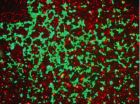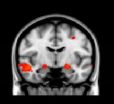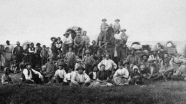(Press-News.org) CHICAGO --- A gel form of tamoxifen applied to the breasts of women with noninvasive breast cancer reduced the growth of cancer cells to the same degree as the drug taken in oral form but with fewer side effects that deter some women from taking it, according to new Northwestern Medicine® research.
Tamoxifen is an oral drug that is used for breast cancer prevention and as therapy for non-invasive breast cancer and invasive cancer.
Because the drug was absorbed through the skin directly into breast tissue, blood levels of the drug were much lower, thus, potentially minimizing dangerous side effects -- blood clots and uterine cancer.
The gel was tested on women diagnosed with the non-invasive cancer ductal carcinoma in situ (DCIS) in which abnormal cells multiply and form a growth in a milk duct. Because of potential side effects, many women with DCIS are reluctant to take oral tamoxifen after being treated with breast-saving surgery and radiation even though the drug effectively prevents DCIS recurrence and reduces risk of future new breast cancer.
The paper was published July 15 in the journal Clinical Cancer Research.
"Delivering the drug though a gel, if proven effective in larger trials, could potentially replace oral tamoxifen for breast cancer prevention and DCIS and encourage many more women to take it," said lead author Seema Khan, M.D., a Northwestern Medicine® surgical oncologist. "For breast cancer prevention and DCIS therapy, effective drug concentrations are required in the breast. For these women, high circulating drug levels only cause collateral damage."
Khan is a professor of surgery and the Bluhm Family Professor of Cancer Research at Northwestern University Feinberg School of Medicine. She also is a surgeon at Northwestern Memorial Hospital and co-leader of the breast cancer program at the Robert H. Lurie Comprehensive Cancer Center of Northwestern University
"The gel minimized exposure to the rest of the body and concentrated the drug in the breast where it is needed," Khan said. "There was very little drug in the bloodstream which should avoid potential blood clots as well as an elevated risk for uterine cancer."
Women who have completed surgery and radiation are given oral tamoxifen for five years to reduce the risk of the DCIS recurring at the same place and of new breast cancer appearing elsewhere in the same breast or the other breast. Tamoxifen is an anti-estrogen therapy for a type of breast cancer that requires estrogen to grow.
Khan and colleagues conducted a phase II clinical trial to compare the effects of the gel, 4-OHT, with oral tamoxifen. They found after six to 10 weeks of gel application that the reduction in a marker for cancer cell growth, Ki-67, in breast tissue was similar to that of oral tamoxifen. The scientists also found equal amounts of 4-OHT present in the breast tissue of patients who used the gel or took the oral drug, but the blood levels of 4-OHT were more than five times lower in those who used the gel.
The reduction in the levels of 4-OHT in the blood also was correlated with a reduction in proteins that cause blood clots.
The study involved 26 women, ages 45 to 86, who had been diagnosed with DCIS that was sensitive to estrogen (estrogen-receptor-positive DCIS). Half the women received the gel, which they applied daily, and half the oral drug, which they took daily.
The gel application may also be more effective for some women. Oral tamoxifen doesn't help all women who take it because it needs to be activated in the liver by specific enzymes and about a third of women lack these enzymes, Khan said. These women may not receive full benefits from the pill.
INFORMATION:
Other Northwestern authors on the paper include first author Oukseub Lee, Katherine Page, David Ivancic, Irene Helenowski, Vamsi Parini, Megan E. Sullivan, Robert T. Chatterton Jr., Borko Jovanovic, Julia Shklovskaya, Silvia Skripkauskas, Piotr Kulesza, David Green, Nora M. Hansen, Kevin P. Bethke, Jacqueline S. Jeruss and Raymond Bergan.
The research is supported by the grant N01-CN-35157 from the National Cancer Institute of the National Institutes of Health and BHR Pharma, LLC.
NORTHWESTERN NEWS: http://www.northwestern.edu/newscenter/
New skin gel fights breast cancer without blood clot risk
Tamoxifen gel stops breast cancer growth and won't cause dangerous side effects
2014-07-15
ELSE PRESS RELEASES FROM THIS DATE:
Game theory model reveals vulnerable moments for cancer cells' energy production
2014-07-15
Cancer's no game, but researchers at Johns Hopkins are borrowing ideas from evolutionary game theory to learn how cells cooperate within a tumor to gather energy. Their experiments, they say, could identify the ideal time to disrupt metastatic cancer cell cooperation and make a tumor more vulnerable to anti-cancer drugs.
"The reality is that we still can't cure metastatic cancer that has spread from its primary organ and game theory adds to our efforts to attack the problem," says Kenneth J. Pienta, M.D., the Donald S. Coffey Professor of Urology at the Johns Hopkins ...
Adolescent males seek intimacy and close relationships with the opposite sex
2014-07-15
July 15, 2014 -- Teenage boys desire intimacy and sex in the context of a meaningful relationship and value trust in their partnerships, according to researchers at Columbia University's Mailman School of Public Health. The research provides a snapshot of the development of masculine values in adolescence, an area that has been understudied. Findings are online in the American Journal of Men's Health.
The researchers studied 33 males who ranged from 14 to 16 years of age to learn more about how their romantic and sexual relationships developed, progressed, and ended. ...
Fish oil supplements reduce incidence of cognitive decline, may improve memory function
2014-07-15
PROVIDENCE, R.I. –Rhode Island Hospital researchers have completed a study that found regular use of fish oil supplements (FOS) was associated with a significant reduction in cognitive decline and brain atrophy in older adults. The study examined the relationship between FOS use during the Alzheimer's Disease Neuroimaging Initiative (ADNI) and indicators of cognitive decline. The findings are published online in advance of print in the journal Alzheimer's & Dementia.
"At least one person is diagnosed every minute with Alzheimer's disease (AD) and despite best efforts, ...
Brain responses to emotional images predict PTSD symptoms after Boston Marathon bombing
2014-07-15
The area of the brain that plays a primary role in emotional learning and the acquisition of fear – the amygdala – may hold the key to who is most vulnerable to post-traumatic stress disorder.
Researchers at the University of Washington, Boston Children's Hospital, Harvard Medical School and Boston University collaborated on a unique opportunity to study whether patterns of brain activity predict teenagers' response to a terrorist attack.
The team had already performed brain scans on Boston-area adolescents for a study on childhood trauma. Then in April 2013 two bombs ...
Study finds unintended consequences of raising state math, science graduation requirements
2014-07-15
WASHINGTON, D.C., July 15, 2014 ─ Raising state-mandated math and science course graduation requirements (CGRs) may increase high school dropout rates without a meaningful effect on college enrollment or degree attainment, according to new research published in Educational Researcher (ER), a peer-reviewed journal of the American Educational Research Association.
VIDEO: Co-authors Andrew D. Plunk and William F. Tate discuss key findings. https://www.youtube.com/watch?v=jwxh1gj-T1M&feature=youtu.be
"Intended and Unintended Effects of State-Mandated High School ...
BUSM study: Obesity may be impacted by stress
2014-07-15
Using experimental models, researchers at Boston University School of Medicine (BUSM) showed that adenosine, a metabolite released when the body is under stress or during an inflammatory response, stops the process of adipogenesis, when adipose (fat) stem cells differentiate into adult fat cells.
Previous studies have indicated adipogenesis plays a central role in maintaining healthy fat homeostasis by properly storing fat within cells so that it does not accumulate at high levels in the bloodstream. The current findings indicate that the body's response to stress, potentially ...
Team studies immune response of Asian elephants infected with a human disease
2014-07-15
CHAMPAIGN, Ill. — Mycobacterium tuberculosis, the organism that causes tuberculosis in humans, also afflicts Asian (and occasionally other) elephants. Diagnosing and treating elephants with TB is a challenge, however, as little is known about how their immune systems respond to the infection. A new study begins to address this knowledge gap, and offers new tools for detecting and monitoring TB in captive elephants.
The study, reported in the journal Tuberculosis, is the work of researchers at the University of Illinois Zoological Pathology Program (ZPP), a division of ...
Protein's 'hands' enable bacteria to establish infection, research finds
2014-07-15
MANHATTAN — When it comes to infecting humans and animals, bacteria need a helping hand.
Kansas State University biochemists have found the helping hand: groups of tiny protein loops on the surface of cells. These loops are similar to the fingers of a hand, and by observing seven individual loops on the surface of E. coli bacterial cells, the researchers found that the loops can open or close to grab iron in the environment.
"These structures are like small hands on the surface of bacterial cells," said Phillip Klebba, principal investigator and professor and head of ...
4 lessons for effective, efficient research in health care settings
2014-07-15
Thousands of studies take place every year in healthcare settings. A report published recently in the American Journal of Preventative Medicine describes how to do many of these studies more rapidly. By taking into account the real-world constraints of the systems in which providers deliver care and patients receive it, researchers can help speed results, cut costs, and increase chances that recommendations from their findings will be implemented.
The lessons come from the My Own Health Report project, a collaboration between seven research institutions with the goal ...
Mormon pioneer mortality rate calculated at 3.5 percent
2014-07-15
The final stanza of the Mormon pioneer anthem "Come, Come Ye Saints" directly confronts the prospect of dying on the trail: "And should we die, before our journey's through…"
Now new research shows that pioneer mortality rates were not much greater than national averages at the time.
This may come as a surprise to modern Mormon youth who've participated in handcart treks.
"The youth go out and learn that a lot of people died and they push the handcart and after three days they think they are practically dead," said retired historian Mel Bashore. "But most people traveled ...
LAST 30 PRESS RELEASES:
Numbers in our sights affect how we perceive space
SIMJ announces global collaborative book project in commemoration of its 75th anniversary
Air pollution exposure and birth weight
Obstructive sleep apnea risk and mental health conditions among older adults
How talking slows eye movements behind the wheel
The Ceramic Society of Japan’s Oxoate Ceramics Research Association launches new international book project
Heart-brain connection: international study reveals the role of the vagus nerve in keeping the heart young
Researchers identify Rb1 as a predictive biomarker for a new therapeutic strategy in some breast cancers
Survey reveals ethical gaps slowing AI adoption in pediatric surgery
Stimulant ADHD medications work differently than thought
AI overestimates how smart people are, according to HSE economists
HSE researchers create genome-wide map of quadruplexes
Scientists boost cell "powerhouses" to burn more calories
Automatic label checking: The missing step in making reliable medical AI
Low daily alcohol intake linked to 50% heightened mouth cancer risk in India
American Meteorological Society announces Rick Spinrad as 2026 President-Elect
Biomass-based carbon capture spotlighted in newly released global climate webinar recording
Illuminating invisible nano pollutants: advanced bioimaging tracks the full journey of emerging nanoscale contaminants in living systems
How does age affect recovery from spinal cord injury?
Novel AI tool offers prognosis for patients with head and neck cancer
Fathers’ microplastic exposure tied to their children’s metabolic problems
Research validates laboratory model for studying high-grade serous ovarian cancer
SIR 2026 delivers transformative breakthroughs in minimally invasive medicine to improve patient care
Stem Cell Reports most downloaded papers of 2025 highlight the breadth and impact of stem cell research
Oxford-led study estimates NHS spends around 3% of its primary and secondary care budget on the health impacts of heat and cold in England
A researcher’s long quest leads to a smart composite breakthrough
Urban wild bees act as “microbial sensors” of city health.
New study finds where you live affects recovery after a hip fracture
Forecasting the impact of fully automated vehicle adoption on US road traffic injuries
Alcohol-related hospitalizations from 2016 to 2022
[Press-News.org] New skin gel fights breast cancer without blood clot riskTamoxifen gel stops breast cancer growth and won't cause dangerous side effects




